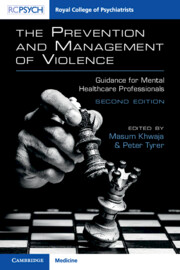Book contents
- The Prevention and Management of Violence
- The Prevention and Management of Violence
- Copyright page
- Dedication
- Contents
- Contributors
- Preface
- Abbreviations
- Section 1 General Aspects of Management
- Section 2 Medical and Psychological Intervention
- Introduction to Section 2
- Chapter 6 Use of Medication and Electroconvulsive Therapy in the Management of Violence
- Chapter 7 Psychological, Psychosocial and Psychotherapeutic Interventions for the Prevention and Management of Violence
- Chapter 8 Prevention and Management of Violence in Inpatient Psychiatric Settings
- Section 3 Violence in Different Settings
- Section 4 Management in Other Groups
- Section 5 Violence and Society
- Section 6 Engagement and Understanding
- Index
- References
Chapter 8 - Prevention and Management of Violence in Inpatient Psychiatric Settings
from Section 2 - Medical and Psychological Intervention
Published online by Cambridge University Press: 09 May 2023
- The Prevention and Management of Violence
- The Prevention and Management of Violence
- Copyright page
- Dedication
- Contents
- Contributors
- Preface
- Abbreviations
- Section 1 General Aspects of Management
- Section 2 Medical and Psychological Intervention
- Introduction to Section 2
- Chapter 6 Use of Medication and Electroconvulsive Therapy in the Management of Violence
- Chapter 7 Psychological, Psychosocial and Psychotherapeutic Interventions for the Prevention and Management of Violence
- Chapter 8 Prevention and Management of Violence in Inpatient Psychiatric Settings
- Section 3 Violence in Different Settings
- Section 4 Management in Other Groups
- Section 5 Violence and Society
- Section 6 Engagement and Understanding
- Index
- References
Summary
Violence and aggression remain common reasons for admission to psychiatric wards, and violence and aggression commonly occur in inpatient psychiatric units. Furthermore, exposure to violence and aggression has a deleterious impact on patient and staff safety, treatment outcomes, staff morale and performance, and on the therapeutic environment. The chapter begins with a discussion of clinical governance and of factors that contribute to violence. The importance of service user and carer involvement is emphasised, as is the need to create a safe and therapeutic ward environment. Sexual safety and comorbid substance misuse is mentioned. Principles of managing acutely disturbed behaviour and the prediction of violence in inpatient settings are summarised. Readers are also reminded of issues pertaining to observation, de-escalation, seclusion and restraint. The extra care area, therapeutic interventions, meaningful activity and the role of psychologists on acute wards to reduce the risk of violence and restricted practices are discussed. The chapter concludes with considerations regarding pursuing criminal proceedings against violent perpetrators and inpatient care in the context of COVID-19.
Keywords
- Type
- Chapter
- Information
- The Prevention and Management of ViolenceGuidance for Mental Healthcare Professionals, pp. 118 - 135Publisher: Cambridge University PressPrint publication year: 2023



